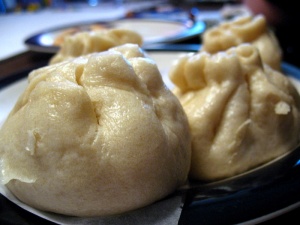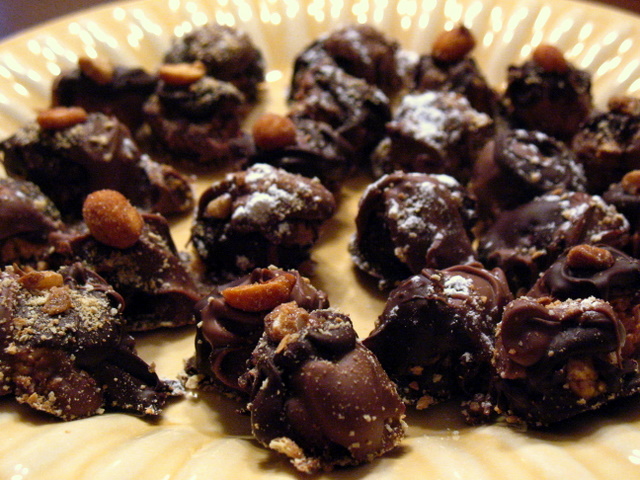
One of the things that interests me about Paula Deen’s recent revelation that she has diabetes (and is now a spokeswoman for Novo Nordisk) is how personally people seem to be taking it. A number of people on my friends’ list on Facebook (I know, the source of all truth) seemed very upset and seemed to view her diagnosis as comeuppance for the way she lives her life/cooks. Anthony Bourdain, who can always be counted on to say something mean if he is allowed to speak, calls her cooking habits “in bad taste” in light of her diagnosis. A number of people have implied that by cooking dishes with high quantities of butter, sugar, and salt, she was somehow intentionally raising the diabetes rates in this country so that she and Novo Nordisk could cash in.
Well, perhaps that’s a bit drastic as a characterization, but I have to say I’m surprised for two reasons:
- Her cooking is, I think, getting slammed unfairly.
- These rants very much absolve her viewers/followers of personal responsibility. If someone got diabetes from cooking a la Paula Deen every day, “It’s not your fault, Paula Deen said it was okay.”
I have to admit I’m a bit of a cooking show junkie, so when I say this about point #1: Paula’s meals are quite fattening, but overall I don’t think the so-called “Queen of Butter” uses more butter than Julia “Butter is Better” Child ever did. In fact, while it’s true that Paula never met something she couldn’t deep fry, Julia certainly matches her with butter, heavy cream, and wine. The major difference between the two of them is in the sophistication of their cooking—Paula Deen gets paid to cook “traditionalesque” southern food, while Julia Child was doing French.
Put this way, the opposition to Paula Deen’s method of cooking smacks of snobbery. It’s okay to use cream and butter if you’re making quiche—Julia’s recipe calls for over two cups of cream, as it happens (a mere 1,642 calories—as Julia once said, “If you’re afraid of butter, use cream.”)—but if you’re making Twinkie Pie, go to hell (for the record, Twinkie Pie uses neither cream nor butter). Of course Julia Child practiced portion control (she talks about it in her book My Life in France, anyway; I don’t think I’ve seen her mention it on her show). Oh, but Paula Deen says she doesn’t suggest anyone should eat the way she cooks every day (or she’s said that in interviews, again I don’t think I’ve seen her mention it on her show). But certainly I think it’s difficult to tar one of them on this count without hitting the other.
As for the second point, well… There is the matter of personal responsibility, certainly, and freedom of thought. I rarely make a recipe without halving the sugar, replacing some butter or oil with margarine or yoghurt, and generally trying to lighten things up. (I make béchamal sauce with skim milk. Julia would be ashamed to be in the same room with me.) But my point is that no one is forcing anyone to make Deen’s recipes or to make them as written. If we are going to claim that cooking as she does is somehow irresponsible, then can we follow it by saying it is irresponsible for a restaurant to serve fried cheese curds (a Wisconsin favorite) to an obese person (there are plenty here)? Don’t people have a right to make their own choices on what they eat? In fact, isn’t this one of the earliest rights that people claim for themselves as children barely removed from infancy?
One thing that struck me as interesting about all these interviews Deen has done is that she mentioned that initially, she didn’t really understand what diabetes was or what it meant that she had it. Recall that we are talking about a woman who grew up in a small town in the South, a place that does not have an awesome educational system, and she did not go to college. I know about diabetes because my mother is an endocrinologist. It’s possible that Ms. Deen did not grow up with these privileges and actually didn’t know, or at least didn’t understand, that this could be the outcome of her lifestyle. From my understanding, it is not unusual for people to go through a period of adjustment and denial when diagnosed with diabetes. Plus, people should be allowed to keep their medical problems to themselves, even if they are public figures.
That said, signing on as spokesperson for Novo Nordisk is opportunistic. I have to admit I don’t like drug companies (because of patenting issues, primarily—I’m not a conspiracy theorist). But it may be the case that she genuinely thought she could help reach out to her audience—people who, like her, may not know much about diabetes—and educate them. And make a tidy sum in the process; she’s a shrewd businesswoman. But I don’t think anyone, least of all Deen herself, is suggesting that with diabetes you can do what you want, then take a pill that makes it all better. Novo Nordisk is suggesting that they approached Deen because they thought it could be cool “to change some of her famously tasty, and butter-rich, and really unhealthy recipes.”
I won’t imply that all cooking shows are created equal when it comes to matters of health, but look at some of the things on Food Network’s lineup:
- Diners, Drive-ins, and Dives: The overweight Guy Fieri goes from place to place and is filmed stuffing his maw with giant piles of meat, cheese, and fried things.
- Sugar High: Duff Goldman, much as I love him, is another chubby guy carting from place to place EATING, in this case, CAKE.
- Hungry Girl: Lisa Lillien really rubs me the wrong way. Never has “healthy” eating seemed less appealing (probably because instead of cooking genuinely healthy food, she takes all kinds of shortcuts so people can still eat their greasy terrible meat by-products without the guilt).
- 30 Minute Meals: Rachel Ray has a terrible smile, and smiling terribly is all she’s good at. But although her food doesn’t seem awful, she doesn’t exactly cook with the precision needed for really healthy cooking. Know what’s the difference between one tablespoon of “EVOO” and three? About 240 calories. That’s the difference between measuring things and approximating.
- Pioneer Woman Cooks: Ok, I happen to like Ree Drummond, and I have cooked stuff off her website…usually cutting the sugar and butter by quite a lot. She lives on a cattle ranch and never met a stick of butter she didn’t love.
- Robert Irvine: I only ever see him on Dinner: Impossible, and most of what he does is yell at people. I’m just pointing him out because he’s the only really ripped chef. In the world.
- Sandra Lee: While Sandra’s Money-Saving Meals is usually fairly healthy, Semi-Homemade sacrifices that for convenience. And while she’s willing to cut calories in food, she spends them on alcohol. I’m convinced she’s not fat only because she doesn’t eat and lives on breath mints and water when she’s not being cryogenically frozen prior to her next taping.
And looking at non-Food Network cooking shows I’ve enjoyed:
- Two Fat Ladies: Exactly what it sounds like. Two fat, elderly women drink and smoke their way across England on a motorcycle, cracking nasty jokes about vegetarians all the while. I love it.
So what’s my point? First of all, it’s not unusual for cooks to be both personally rotund and cook unhealthy food. Second of all, this industry is ALL ABOUT cashing in on people’s love for highly caloric, fried, cheesed, delicious food. Third, Paula isn’t alone in cashing in on the latest health scare: FN announced a new series called Fat Chef which premiers 26 January. I can only assume that this is a less abusive version of Biggest Loser.
Finally, to blame Paula Deen for advancing the cause of diabetes through her cooking is to miss the whole tragedy of the cooking show. While record numbers of people are overweight, and cookbooks sell well and cooking shows are super popular, most of these people don’t cook. As Michael Pollan puts it, the Average American spends 27 minutes per day on food preparation, and cooking from scratch is all but dead (officially, “cooking” means you have to assemble elements—heating up a pizza, for example, doesn’t count, though making a sandwich does). That makes me a statistical anomaly, since I cook from scratch (I make sauces! I bake things without mixes! I make non-instant rice and lentils!) at least 3-4 times per week. People are not getting fat off of Paula’s deep-fried ham (or haa-yam, y’all) because they are not cooking it. They’re watching her cook, then having dinner at McDonald’s.
So rage against Paula Deen all you want. Unfortunately, it’s not going to help anything.




 lems removing the truffles from the cookie sheet and putting them on a plate.
lems removing the truffles from the cookie sheet and putting them on a plate.